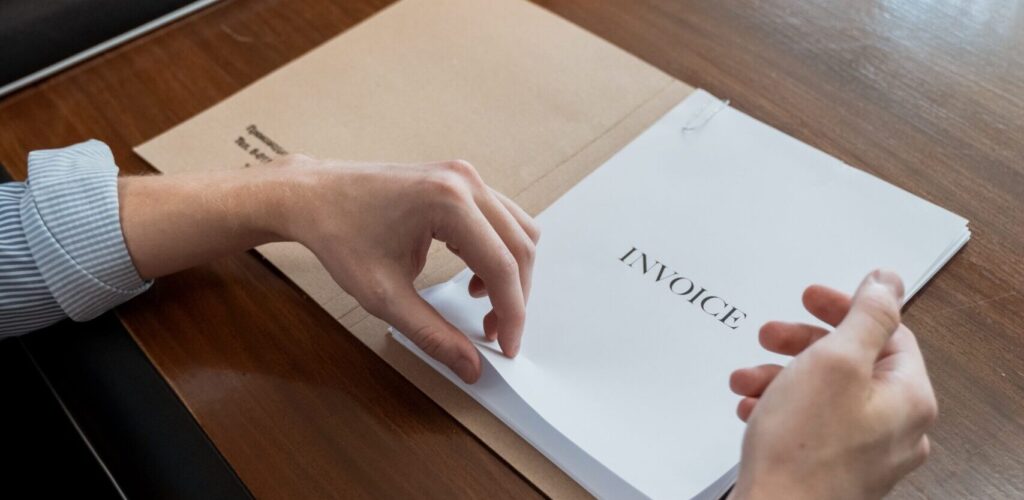Knowing how to invoice correctly is one of the most important parts of running a business. As well as ensuring you get paid for the goods or services your business has provided, invoicing is also crucial when it comes to keeping accurate tax records.
Our guide explains how to write an invoice, as well as when invoices are needed and how to send them.
What is an invoice?
An invoice is simply a bill that you send to your customers or clients to ask for payment for the goods and services you’ve provided. The invoice should include a description of the services or goods, along with the payment amount, payment terms and payment method.
As well as helping to ensure you get paid, invoices are also important for bookkeeping as they help prove your income.
Having an accurate record of your invoices will help when you come to file your tax return. Invoices can also act as legal proof that you carried out a service if you do not get paid and need to take further action.
When are invoices required?
You will need to send an invoice to a customer or client if they have purchased goods or services from you. An invoice states in writing what the client has purchased, the date they purchased it and how much they are being charged for it.
An invoice should be sent out whenever you need a client or customer to pay for the goods or services they have purchased. For this reason, it’s important to set aside some time each day or week to catch up with your invoicing, otherwise it can be easy to lose track of who owes you what.
Invoices are different to receipts that acknowledge payment. They are also different to purchase orders that notify intent to buy goods and services.
What is included in an invoice?
Your invoice should include the following information:
- A unique identification number
- Your company name, address and contact number
- The company name and address of your client
- A clear description of what you’re charging for
- The date the goods or services were provided
- The date of the invoice
- How much you’re charging
- Tax if applicable
- The total amount owed
Sole traders should also include their own name and any business name being used, as well as an address where any legal documents can be delivered if you are using a business name.
Limited companies must include the full company name as it appears on the certificate of incorporation. If you want to put the names of your directors on your invoices, you will need to include the names of all directors.
How do I structure an invoice?
You can create invoices manually by following templates available online, or you can create them by using accounting and invoicing software and services. You should structure your invoice in the following way:
- Brand your invoice
It’s a good idea to use your company logo and distinct colours at the top of your invoice as this can make your business look more professional and build up a reputation. If you’re a freelancer, you might not have a logo, but it’s still worth putting your name clearly at the top.
- Clearly mark your invoice
Ensure you use the word ‘invoice’ at the top of the document so that it can be easily identified as this can help you get paid on time. Also add a unique identification number so that you can easily keep track of each invoice and avoid duplicates.
- Add company details
Next, add your company or personal name and address and phone number. This should be towards the top of the invoice so that the customer can quickly see who the invoice is from.
Also add your customer’s company name and address, including a contact’s name so it reaches the right person.
- Add a description of the goods or services provided
Clearly state what goods and services have been provided so that your customers know what they are paying for. You also need to add in the quantity of each and the price.
- Include dates
It’s also important to add dates to your invoice. You should include:
- The date you created the invoice
- The date you provided the goods or services
- The date due for payment
- A breakdown of costs and totals
You then need to state the total amount owed, including any discounts you’ve applied and tax where applicable. Make sure you are as clear as possible to avoid any confusion or disagreements. It’s best to double check your figures to ensure you haven’t made any mistakes.
Do I include payment information on an invoice?
Yes, it’s crucial that you include payment information on an invoice to ensure you get paid on time. State exactly how you wish to be paid, whether that’s cash, card, direct bank transfer or PayPal, and make sure you include all the relevant account details.
It’s also best to include payment terms on your invoice. You should have agreed these with your customer in advance, but it’s also worth putting them on the invoice. For example, you might state that your payment should be made within 14 days. Other common timeframes are 30, 60 or 90 days.
If a payment is late, it’s best to politely chase it up by email a day or two after the payment was due to be received. If you have no reply, try emailing again. If you still have no response, you will need to phone the client to find out what’s happening. Make sure you keep records of all correspondence, including who you talked to and when.
In most cases, your invoice should be paid after a gentle nudge, but if not, you might have to talk to a solicitor and consider legal action.
Can a digital invoice be formatted the same as a physical one?
Yes, digital invoices can be formatted in the same way as a physical one. The main advantage of this is that you can simply follow a template and then reuse this to create new invoices in a matter of minutes. Sending your invoices by email will also make them easier to keep track of compared to delivering paper copies by hand or hoping they don’t get lost in the post.
How do I send an invoice?
Invoices were traditionally either hand delivered or sent by post. But nowadays it’s much easier to create an invoice digitally and then send it via email. It’s good practice to write a clear subject line with your business name and ‘invoice’ included, plus a brief description of the services provided in the body of the email. Then attach the invoice to the email as a downloadable PDF. This will ensure your customer can save, print or upload the invoice to their accounting software.
Make sure you send the invoice/email to both the person who authorises the payment and the person who processes it where needed.
Is there invoicing software I can use?
Yes, there’s a variety of invoicing software you can use to help you. This software enables you to easily create invoices by following a template, but it can also help you to send multiple invoices simultaneously and reduce the risk of making mistakes. Invoicing software can also make it easier to keep track of which invoices have been sent and when, and it can automatically chase late payments for you.
Some of the invoicing software to look at includes:
QuickBooks – Whatever your business size, QuickBooks is a general accounting app that can help you to send invoices instantly by using handy templates and get paid fast by adding PayPal’s ‘Pay Now’ button. You can also set up recurring invoices that are payable by GoCardless direct debit, receive reminders of when invoices are due, and know when they’ve been opened and paid.
FreshBooks – You can create customised invoices easily with the FreshBooks invoice generator. It’s also easy to send reminders and charge late fees where applicable, set up recurring invoicing and keep track of when invoices have been sent.
KashFlow – You can use your accounting software to convert quotes to invoices and automatically send them to customers, complete with your own logo and branding. It’s also possible to set up multiple payment methods and include a ‘pay now’ button on your invoices to get paid faster. Plans start from
Zoho Invoice – This is an online invoicing software that helps you create invoices, send payment remainders and keep track of expenses. You will be able to choose from a range of invoice templates, send invoices efficiently and keep track of when they’ve been sent, as well as follow up with automated payment reminders and provide multiple payment options. And the best bit is, it’s completely free of charge.
Some business bank accounts, such as Anna Money and tide, also include invoicing services so these are worth looking at too.






 yet? Register here!
yet? Register here!